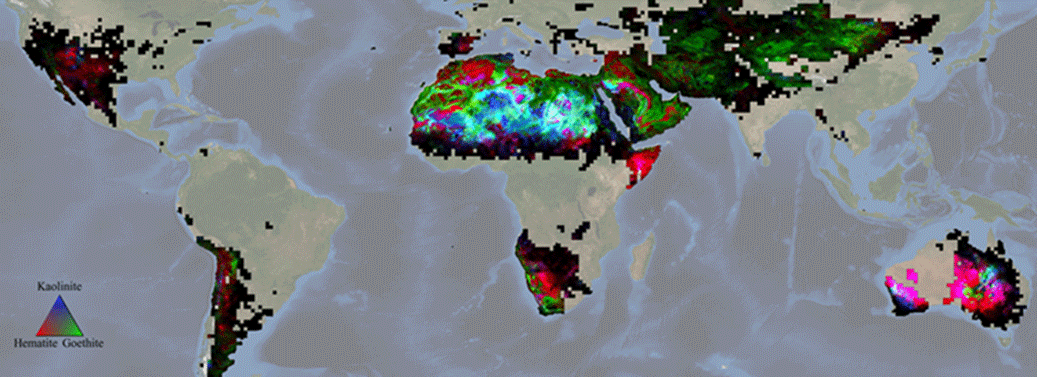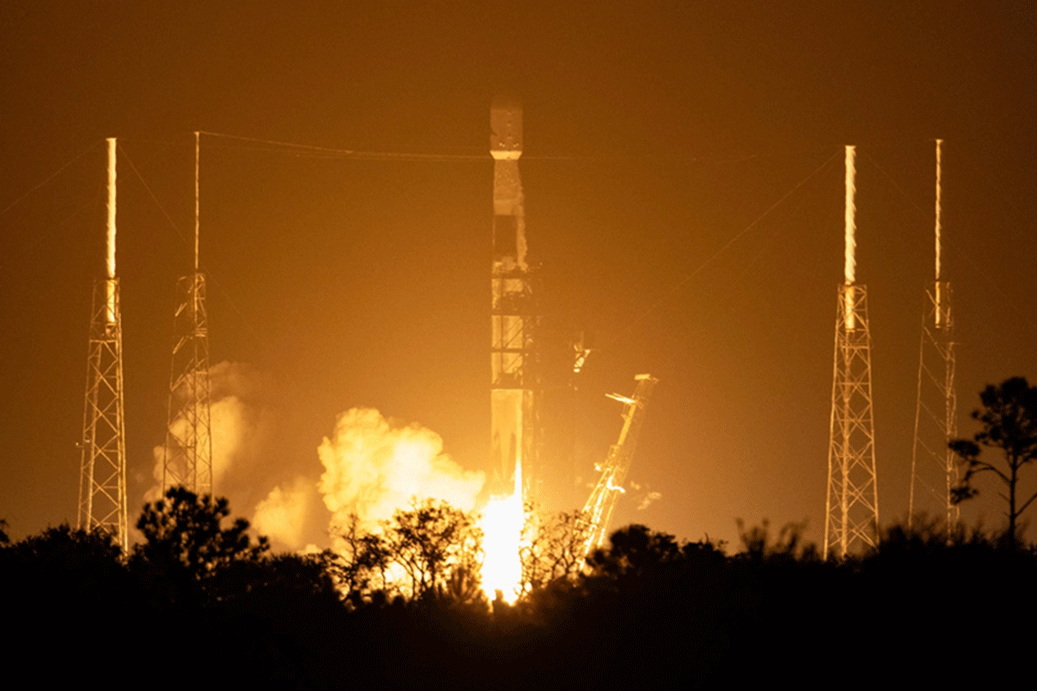It is early 2024 as this issue of The Earth Observer is published online (see the original PDF version of the entire issue here) and we have exciting news to share about the successful launch of a new NASA mission. On February 8, 2024, at 1:33 AM EST, NASA’s Plankton, Aerosol, Cloud ocean Ecosystem (PACE) mission took to the skies aboard a Falcon 9 rocket launched from Cape Canaveral Space Force Base in Florida—see Photo below. NASA confirmed signal acquisition from the satellite about five minutes after launch, and the spacecraft is performing as expected. Now the PACE team can turn its attention to testing the instruments and preparing them for science operations.
Managed by NASA’s Goddard Space Flight Center (GSFC), the PACE payload includes a state of the art Ocean Color Instrument (OCI) designed and built at GSFC—which will continue NASA’s more than 40-year time series of ocean color measurements. PACE also flies two polarimeters: the Hyper-Angular Rainbow Polarimeter #2 (HARP2) designed and built by the University of Maryland, Baltimore County (UMBC) and the Spectro-polarimeter for Planetary Exploration one (SPEXone) developed and built by a Dutch consortium led by SRON Netherlands Institute for Space Research, Airbus Defence, and Space Netherlands. These two instruments will make independent measurements of the angular distribution of polarized reflected sunlight. While such details are invisible to the naked eye, they are crucial for understanding the size, composition, and concentration of atmospheric particles (or aerosols) and clouds. A Visualization (also included in the “NASA Earth Science in the News Column” of this issue) provides more details on the role of the two PACE polarimeters, some applications for polarimetry data, and how the PACE team will process the vast amounts of data generated by this mission.
The inclusion of these two polarimeters on PACE is the fulfillment of a long-desired capability for NASA Earth science. Building on the heritage of several polarimeters used for planetary exploration in the 1970s and 1980s, an Earth Observing Scanning Polarimeter (EOSP) was part of the original Earth Observing System platform concepts in the early 1990s. While EOSP was ultimately not included as part of the EOS flight hardware, NASA’s Goddard Institute for Space Studies (GISS) developed a suborbital version called the Research Scanning Polarimeter (RSP), which has flown in various campaigns since 1999 to test polarimetric techniques. An updated version of EOSP (renamed the Aerosol Polarimetry Sensor, or APS) would have been part of NASA’s Glory mission, which failed to reach orbit in 2011. Finally, nearly 13 years later with the launch of PACE, not one but two space-based polarimeters will be in operation.
My congratulations to the entire PACE team for a successful launch. As with many missions, the PACE launch is the culmination of years of development and would not have become reality without the dedicated efforts of many individuals who have worked hard to reach this point and who will continue to work as the mission unfolds. The science and applications communities eagerly await the data from this new mission.
Speaking of applications, to ensure the PACE mission and its anticipated data products meet the needs and objectives of applied-user and stakeholder communities, NASA’s PACE Applications Program has been established to build partnerships between data product developers, data distributors, and data users. The latest in a series of successful PACE Applications Workshops took place in September 2023. The workshop offered opportunities for participants to connect, contribute, and collaborate. Prior to the event, workshop organizers polled registrants to share their backgrounds, expertise, interests, and demographics to facilitate a relevant workshop with engaging conversations.
Staying on the subject of aerosols, NASA’s Earth Surface Mineral Dust Source Investigation (EMIT) mission closed out 2023 with an exciting new achievement, as it produced the first comprehensive maps of the world’s mineral dust-source regions—see Figure below. The maps are based on data from the year ending November 2023 and show concentrations of important minerals in Earth’s dry regions.

Launched to the International Space Station in 2022, EMIT is an imaging spectrometer developed by NASA/Jet Propulsion Laboratory (JPL). The mission collected billions of measurements and mapped key minerals that can affect climate when lofted into the air as dust storms (through their influence on aerosol composition), thus providing scientists with crucial new information to model related impacts. To date, the mission has captured more than 65,000 scenes, or 50 x 50-mi (80 x 80-km) spectral-image-cubes of the surface, including arid regions within a 6900-mi (11,000-km) wide belt around Earth’s mid-section below the International Space Station. Detailed maps of surface composition are derived from the billions of spectroscopic measurements within this data set that is openly available from the Land Processes Distributed Active Archive Center (LP DAAC).
During its 17 months in orbit, EMIT has demonstrated additional capabilities beyond its primary mission, including measuring plumes of methane and carbon dioxide being emitted by landfills, oil facilities, and other localized sources.
Closer to the ground, NASA’s Goddard Space Flight Center’s (GSFC) Southern Hemisphere Additional OZonesondes (SHADOZ) network, which coordinates balloon-borne ozonesonde launches from 14 tropical sites through global partnerships, has reached two milestones this year: 25 years of operation and the archiving of 10,000 ozone and pressure-temperature-humidity datasets.
The project was initiated in 1998 by NASA–GSFC, NOAA’s Global Monitoring Division, and international co-investigators. The collective data set—derived from the 14 stations launching ozonesondes in the SHADOZ network—provides the first climatology of stratospheric and tropospheric tropical ozone in the equatorial region, enhancing validation studies aimed at improving satellite remote sensing techniques for tropical ozone estimations, and serves as an educational tool to students, especially in participating countries.
The 2023 archive is expected to hit 400 profile pairs from 14 stations, bouncing back from reduced operations during the COVID-19 pandemic.
Celebration of both its 25-year milestone and collection of its 10,000th total ozone profile in 2023 offered an opportunity to reflect on the transformative scientific contributions of the SHADOZ program.
Shifting focus to NASA’s education and public outreach activities, since its establishment in 2016, NASA’s Science Activation (SciAct) program has implemented a collective-impact, network-of-networks approach, with teams reporting 525 active external partners as of 2022. The SciAct program supports, leads, and coordinates collaboration across a cooperative, nationwide network of 50 competitively selected SciAct teams and NASA infrastructure activities.
These teams of community-based learning providers, educators, and experts work together to connect diverse learners of all ages with exciting NASA content and authentic science experiences. In 2022, the Science Activation program facilitated 52 million learner interactions in the U.S. and a quarter-million abroad. The program is now working to bolster its already impressive reach and engagement successes through enhanced communications and social media strategies that leverage NASA’s extensive networks.
Every NASA mission is designed and funded for a projected operation lifetime. Missions that are still functional at the end of their primary operational phase are asked to submit proposals for a Senior Review, currently on a three-year cadence, in which a science community panel and sub-panels are convened to “evaluate the scientific performance of each mission and the continued relevance of each mission to the NASA Science Strategic Plan.” Performance factors include scientific merit, national needs, the technical status of the mission, and budget efficiency.
The most recent Earth Science Senior Review took place during 2023, with proposals submitted in April for extensions in fiscal years 2024–2026. Twelve NASA Earth Science missions in extended operations were evaluated: Aqua, Aura, CYGNSS, DSCOVR (Earth Science Instruments: EPIC and NISTAR),
GRACE Follow-On, GPM, ICESat-2, OCO-2, SAGE III on ISS, SMAP, Terra, and TSIS-1. Of these, eight missions (DSCOVR, GRACE Follow-On, GPM, ICESat-2, OCO-2, SAGE III, SMAP, and TSIS-1) were endorsed for extension for the fiscal years 2024–2026 and are expected to be invited to the 2026 Senior Review for further extension. CYGNSS was extended through fiscal year 2025—with continued operations beyond fiscal year 2025 contingent upon the team addressing the findings of the 2023 Senior Review and the successful completion of an interim review to assess their progress. Aqua, Aura, and Terra were extended to their estimated natural end of life based on the remaining fuel/power in their drifting orbits. In addition, Out-of-Cycle Senior Reviews for four other ISS missions (ECOSTRESS, EMIT, GEDI, and OCO-3) took place in late 2022 and 2023.
The 2023 Earth Science Senior Review panel report for the 12 in-cycle missions was released in October 2023. The panel report emphasizes that the challenge of supporting “existing missions and their data products beyond their design lives as well as supporting the new missions identified in the [2017 Earth Science] Decadal Survey is entirely the product of the success of NASA’s Earth Science Division (ESD).” Congratulations to all the mission teams for their hard work in preparing proposals, and special thanks to all review panel members for their willingness to participate in this critical activity. The ESD response for all out-of-cycle and in-cycle missions is also available.
Last but certainly not least, I’m happy to report the successful completion of a long-standing goal for The Earth Observer Team. Readers now have access to the complete online archive spanning the last 35 years of newsletter publications—dating to the very first issue published in March 1989! Nearly every past “hard copy” issue has been meticulously optically scanned and uploaded to our archives page, and an effort to improve search engine optimization (SEO) for the early newsletter content is underway, thereby enhancing the archival value of the nascent years of NASA Earth Science.
This achievement aligns with the release of this issue of The Earth Observer—which will be the final bimonthly PDF issue published. During 2023, the team planned its transition to posting individual articles online and has been working to transition to a new content management system (CMS). The new CMS is projected to debut no earlier than March 2024—which coincides with the 35th anniversary of The Earth Observer. We aim to notify our readers about freshly uploaded content on our website through weekly email alerts that include a direct link to our newsletter in your inbox. Our commitment is to keep subscribers informed about the latest developments through various communication channels, which we will notify readers of as they become available.

Steve Platnick
EOS Senior Project Scientist
























